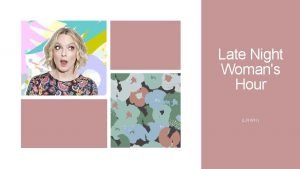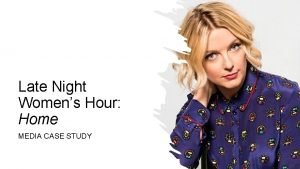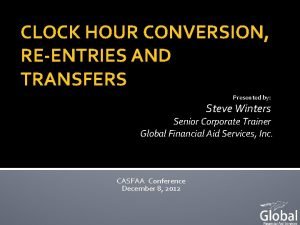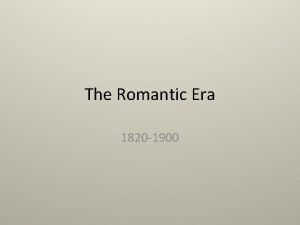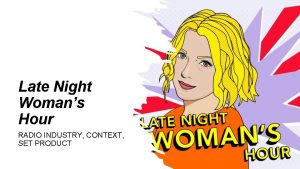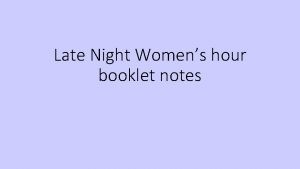Late Night Womans Hour MEDIA INDUSTRIES Product Context










- Slides: 10

Late Night Woman’s Hour

MEDIA INDUSTRIES - Product Context • Late Night Woman’s Hour is a spin-off from the long-running BBC Radio 4 daily magazine programme, Woman’s Hour. • Late Night Woman’s Hour is broadcast once a month, late at night, is presented by Lauren Laverne and features a number of female panellists. • Each episode focuses on a particular theme relevant to its female audience e. g. ‘home’ and ‘forgiveness’. • It began broadcasting in 2015

Historical Contexts • The original Woman’s Hour first broadcast in the 1940 s – this could be seen as a minority audience programme – one hour a day or week set aside just for a female audience. This might further suggest that all other programming on BBC Radio was aimed at a male audience. • Further, this might suggest a strong sense of patriarchal control, both on the BBC and in UK society at the time • LNWH features frank and open discussion, and demonstrates a shift in society and increased gender equality although some of the issues raised reflect the fact that society is not yet completely equal.

Institution and Economics • The BBC raises its finances from the license fee – currently at £ 147 per year – and is paid by the UK population in order to consume TV and radio broadcasts, whether they are BBC products or not. • Since 1922 the BBC has been committed to its mission to inform, educate and entertain • Late Night Woman’s Hour could be seen as a typical example of Public Service Broadcasting (PSB) and therefore of the BBC, due to its ‘niche’ audience. • It could be argued that commercial broadcasters (those who are set up to make a financial profit through advertising) might see a programme like LNWH as being too specialised, aimed at a relatively small audience and broadcast at an unpopular time. • Purely commercial institutions would be less likely to produce a product like this due to the relatively low audience figures, lack of sponsorship or advertising deals to tie-in with the programme, and its specialist nature. • The programmes have only female contributors, is made up predominantly of just dialogue (without music, sound effects etc. ) and the topics explored use intellectual and specialised vocabulary. • The BBC, however, have a commitment to producing a wide selection of content, aimed at all sections of the population. In which case, LNWH could be seen as a ‘typical’ BBC product.

Technological change and media production, distribution and circulation and the impact of digitally convergent media platforms • Scheduling - Late Night Woman’s Hour has an 11 p. m. broadcast timeslot. However, audiences can now listen on digital devices other than radios and download podcasts to enjoy at their leisure which means the time a broadcast airs live might be less significant. • Digital technology, such as Digital Audio Broadcasting (DAB), possibly offers broadcasters like the BBC more freedom to produce challenging content which would normally got out after the 21. 00 watershed (the time which more ‘adult’ themes can be shown on TV and radio, such as violence or language), and still be heard at any given time though downloadable content.

Theoretical approaches – Power and media industries (Curran and Seaton) • It could be argued that programmes like LNWH, and the general product output from the BBC, challenges the idea that the media is run purely for economic profit and power, while being controlled by a small number of powerful companies, such as Sky, News Corporation and Disney. • Late Night Woman’s Hour might also be used to support Curran and Seaton’s idea that socially diverse patterns of ownership help create conditions for varied and adventurous productions. • It could be argued that the success and growth of podcasts across a range of topics and genres could also be due to the relative inexpensive production costs and hosting facilities on a range of divergent technologies. • Podcasts are also available to a wider global audience, which widens the target market.

AUDIENCES – How audiences are grouped and categorised by media industries, including by age, gender and social class, as well as by lifestyle and taste • The audience for Radio 4 generally can be categorised in terms of age, social class and expected levels of education. This referred to as Demographics. • A stereotypical Radio 4 listener is likely to be educated often to degree level, be in a managerial/senior/educational job environment, upper-middle class, aware of current affairs – and most likely male • Lauren Laverne was once a member of an indie-rock band, Kenickie, in the 1990 s. This would make her an untypical ‘Radio 4 -type; presenter.

How audiences interpret the media and how and why audiences may interpret the same media in different ways • The nature of the programmes are not solely female-targeted material, but quite often it does take an exclusive female ‘take’ on the subjects. • The broadcast has been designed to invite audience members to enter the discussion through social media platforms – Twitter being the most popular form of response.

Audience targeting for LNWH • Highlights the nature of PSB and the BBC’s mission of inform, educate and entertain. Designed to explicitly appeal to a specialised (educated, female) audience, with potentially a younger age group than usual for Radio 4. This might be due to the content of the programmes and the makeup of the guests. • The programme may also be targeting a younger audience (late teens to early thirties) with the variety of subjects featured in the series

THEORETICAL APPROACHES – Hall’s Reception Theory / Feminist Theory • Lack of male representation • Not often female dominance is reversed and the ways in which it is often likely that males will dominate a media text. • Radio for women about women by women • The series provides women with a vehicle through which to discuss and construct representations of gender • The set product programme – ‘Home’ – sets up a diverse and challenging discussion on the subject and the changing place of women within that environment
